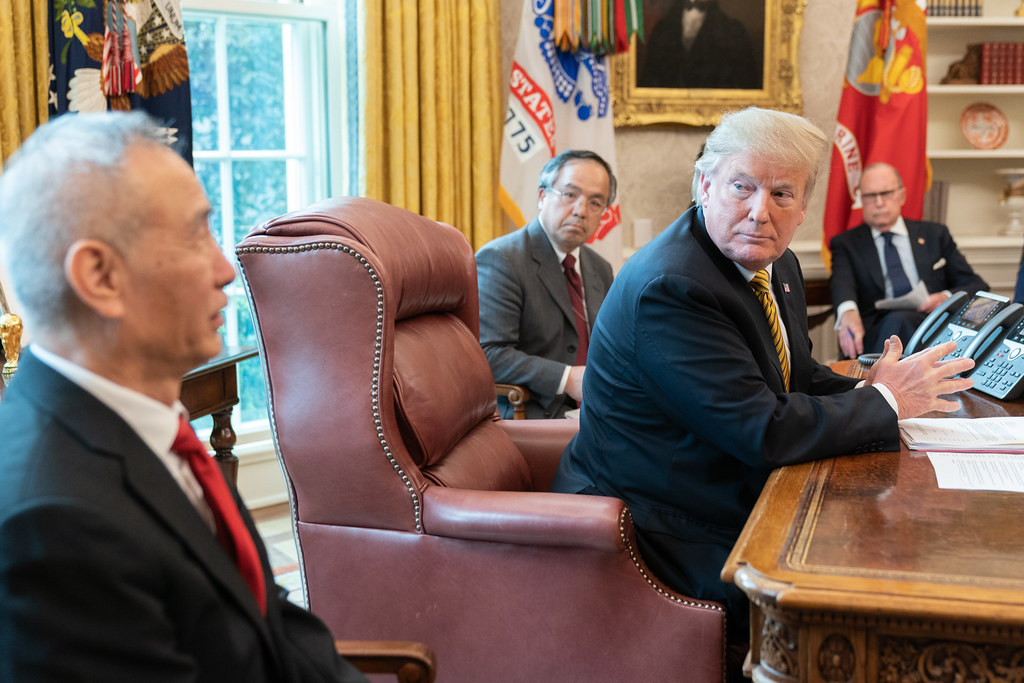Trade Talks Resume in Shanghai
Face-to-face trade negotiations resumed this week between representatives of the United States and China for the first time since President Donald Trump and Chinese President Xi Jinping agreed to restart talks in June. U.S.

Published by The Lawfare Institute
in Cooperation With

Face-to-face trade negotiations resumed this week between representatives of the United States and China for the first time since President Donald Trump and Chinese President Xi Jinping agreed to restart talks in June. U.S. Trade Representative (USTR) Robert Lighthizer and Treasury Secretary Steven Mnuchin traveled to Shanghai for meetings with Vice Premier Liu He. The talks concluded on Wednesday with little progress. The next round of talks will occur in September.
Although the resumption of talks is a positive sign, expectations for a substantive deal were low heading into this week. In the lead-up to the discussions, Trump and his advisors downplayed the prospects for a deal and attempted to frame the trade war as a net success for the United States. The president announced, “I don’t know if they’re [the Chinese government] going to make a deal…I don’t care, because we’re taking in tens of billions of dollars’ worth of tariffs.” However, the U.S. economy has not been immune from the trade war’s effects; the tariffs have been cited as one reason for a possible forthcoming interest rate cut by the Federal Reserve.
The climate for reaching a deal has also deteriorated since the last round of negotiations broke down in May as a result of actions on both sides. The United States placed Chinese tech telecom giant Huawei on the Department of Commerce’s Entity List, which threatens its access to components from U.S. suppliers. The Chinese government, meanwhile, has issued draft regulations for the PRC Cybersecurity Law that could place additional vague restrictions on U.S. businesses, including limiting their ability to send data out of China and requiring operators of what the law deems “critical information infrastructure” to undergo ill-defined cybersecurity reviews.
Rather than focusing on an overarching deal, the negotiations were expected to focus on a relatively narrow set of goodwill measures agreed to by each side. In particular, China had committed to increase purchases of U.S. agricultural products, while the United States said it would delay the introduction of tariffs on an additional $300 billion in Chinese goods and consider permitting American companies to supply Huawei with components widely available on the commercial market that do not threaten U.S. national security.
The specter of the U.S. presidential election has also begun to loom over the trade talks, although exactly what impact the election will have remains unclear. Trump tweeted on July 30 that he expected the Chinese negotiators to attempt to prolong the discussions until after the election and threatened “that if & when I win, the deal that they get will be much tougher than now…or no deal at all.” Meanwhile, a group of American executives who met with Chinese officials last week emphasized that if the two sides could not come to an agreement by the end of the year, it would be difficult to reach one thereafter as the presidential campaigns ramp up.
Trump calls on WTO to stop treating China as a “developing economy”
On July 26, the White House published a memorandum from President Trump to USTR Lighthizer on the topic of World Trade Organization (WTO) reform. The memorandum argued that the “WTO continues to rest on an outdated dichotomy between developed and developing countries that has allowed some WTO Members to gain unfair advantages.” Under the WTO Agreements, developing countries do receive special rights, including, for example: “longer time periods for implementing Agreements and commitments” and support for building the “capacity to carry out WTO work.” Member countries announce for themselves whether they are developing or developed countries, though, as the WTO notes, “other members can challenge the decision of a member to make use of provisions available to developing countries.”
Trump argued that many countries “take on weaker commitments under the WTO framework by designating themselves as developing countries.” The President cited as examples countries like Brunei, Kuwait, Macao, Qatar, Singapore and Turkey, but singled out China for criticism. The memorandum argued that “China most dramatically illustrates the point” and dedicated three paragraphs to descriptions of China’s economic prowess. China, the memorandum noted, ranks “first in the world for exports of high-technology products” and is home to “120 of the world’s 500 largest companies.”
The president called on Lighthizer to “use all available means to secure changes at the WTO that would prevent self-declared developing countries from [unjustifiably] availing themselves of flexibilities in WTO rules and negotiations.” If Lighthizer fails to achieve a breakthrough within 90 days, he is authorized by the president to no longer treat “as a developing country for the purposes of the WTO any WTO Member that…is improperly declaring itself a developing country.” Lighthizer will also have discretion to “not support any such country’s membership in the OECD.” In response to the president’s memorandum, Lighthizer published a statement applauding “the President’s leadership in demanding fairness and accountability at the WTO.”
Despite the fact that the United States has won big in past WTO cases against China, Trump has launched a wide-ranging assault on the WTO, arguing that the organization is outdated and has done little to hold China to task. Perhaps fittingly, the memorandum comes just days after a ruling against the U.S. by the WTO’s Appellate Body. In 2012, the Chinese government challenged U.S. anti-subsidy tariffs on goods such as solar panels, steel cylinders, and aluminum extrusions. The ruling said that the United States must use Chinese prices to measure subsidies, even though the U.S. argued that such prices were distorted. The USTR issued a statement arguing that the appellate report “undermines WTO rules” and criticizing the “Appellate Body’s functioning.”
The Trump administration has not only spoken out against the WTO, but has in certain cases acted to hamstring the organization. Most significantly, the Trump administration has blocked new appointments to the Appellate Body as judges’ terms end. The Appellate Body needs three judges to function. With two of the remaining three judges set to finish their terms on December 10, 2019, member countries of the WTO could lose the ability to appeal panel findings by the end of this year. Canada and the EU have, in the meantime, agreed to refer future disputes to an alternative body made up of former Appellate Body judges. Yet the July 26 memorandum makes clear that Trump’s concerns about the WTO extend well beyond the appellate mechanism to cover core aspects of the WTO system. How the organization responds to the memorandum, and how Lighthizer acts after the 90-day period, could carry significant consequences not just for China, but for the global trading system.
In Other News
- On July 22, China launched a new Nasdaq-style high tech board, called the Science and Technology Innovation Board, or “Star Market.” The Shanghai Stock Market operates Star. Xinhua heralded Star’s launch as “kicking off a trail-blazing leg of the country’s innovation drive and capital market reform.” Other outlets were less enthused. CNBC noted that this is the “third time in 10 years that China has established a new major equity market.” The Financial Times argued that “many of the 25 companies that listed this week might struggle to blend in alongside the likes of Apple, Facebook, and Amazon.” There are reasons for optimism about the exchange’s potential. Most significantly, President Xi’s personal involvement with the program—he announced the new tech board in November of last year and has publicly called for capital markets reform—means that the Star Market will continue to enjoy high-level support.
- Alibaba subsidiary Pingtouge has released the XuanTie 910, a chip processor with possible applications ranging from autonomous driving to 5G telecommunications. The processor uses RISC-V instruction set architecture--open-source design that allows developers to build products “with few intellectual property restrictions.” One analyst, writing for the Register, noted that details of the chip are “curiously thin.” The XuanTie 910’s success could introduce a “new revenue stream” for Alibaba and drive the company’s burgeoning “cloud services division.” The XuanTie 910’s success could also carry global ramifications. Due to the trade war, the Chinese government has promoted chip self-sufficiency in an effort to lessen reliance on U.S.-sourced chips. The release of the XuanTie 910 thus marks a key step in that drive towards technological self-sufficiency.
- The Chinese state-run Global Times has reported that the U.S. equipment manufacturer Flextronics detained some 700 million yuan worth of goods and equipment belonging to Huawei after the Trump administration placed Huawei on a trade blacklist in May. Following the Trump administration’s move, Flextronics ceased cooperating with Huawei, although a senior Huawei executive has indicated that Huawei has since been able to retrieve some 400 million yuan of goods after negotiations with Flextronics. The Global Times suggested that Flextronics is likely to be listed on China’s new “unreliable entity list” for having violated domestic law through its actions against Huawei.
Commentary
In Foreign Affairs, former U.S. Ambassador to the United Nations Nikki Haley puts forth a new strategy for the U.S. relations with China and argues that a “whole of nation” not just a “whole of government” approach is required. For the Center for Strategic and International Studies, William Alan Reinsch discusses whether a U.S-China trade deal would actually have an effect on the theft of intellectual property from U.S. firms. For the Mercator Institute for China Studies, Helena Legarda and Meia Nouwens make the case for why NATO needs a comprehensive China policy as the Chinese military continues to grow stronger.
A new report for Brookings by Jonathan Pollack and Jeffrey Bader considers the consequences of greater disengagement between the United States and China. In Foreign Policy, Lara Seligman interviews Representative Mark Green (R-Tenn.) about new legislation to counter Chinese theft of American intellectual property. Elsa Kania explains why the United States needs to invest more in Chinese language training and expertise to train the next generation of government experts.
For Lawfare, Herb Lin and Bruce Schneier both analyze Attorney General William Barr’s recent speech on encryption, while Eli Sugarman and Heath Wickline explain why the dearth of high-quality cybersecurity imagery impedes popular understanding of the issue.






